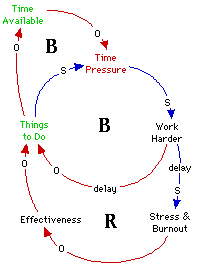
What better to occupy one's mind late on a sleepless night
than Time Management. This is not the first time my thoughts have
been captivated by Time Management. Time Management seems to be
something I have pondered at length, usually when I have less
than enough time to get something done.
It seems that when faced with recurring time pressure we turn
to the concepts of Time Management believing that it holds the
answer for an escape from our dilemma. This in fact constitutes
a two part fallacy.
Lets get serious, there is no management of time in Time Management.
Time is not manageable! Time simply is. As Zig Ziggler is so fond
of saying, "We all have the same amount of time, 24 hours
in every day." It's really a question of what one does within
that time that makes the difference.
The second part of the Time Management fallacy is based on the
belief that if one simply becomes more effective, a better time
manager, then they will be able to accomplish what needs to be
done--NOT!
What is to follow is a anasynthis, i.e. analysis and synthesis,
of one's activity within time in an organizational context. The
intent is to provide a foundation for a deeper level of understanding
regarding the dilemma faced, and provide some more meaningful
approaches that can be taken to resolve the Time Management dilemma.
If this is your first encounter with the systems thinking diagrams
which follow there are rather lengthy descriptions of how to read
the diagrams in both Melting
the Tip of the Iceberg and Victims
of the System or Systems of the Victim.
I suppose the best place to start is with the situation as it's
perceived, experiencing Time Pressure.

The interaction of Time Available and Things
to Do results in Time Pressure. As Time
Available increases the Time Pressure
experienced decreases. As Things to Do increases
Time Pressure experienced increases. From this
perspective, there are three ways to deal with the situation,
increase the Time Available, decrease the Things
to Do, or just live with it. There are actually additional
ways to deal with the situation. These are embedded in elements
of the system which have not yet been described.
The situation being described assumes an organizational context
and the individual experiencing Time Pressure
might be an individual contributor or a manager. I don't think
it will change the way the system unfolds. Within this context
it is generally perceived that the those things in the Things
to Do category can not be ignored--they must be dealt
with.

From this perspective Time Pressure influences
Action which after some delay reduces Things
to Do. The reduction of Things to Do
has two effects. First, reducing Things to Do
decreases Time Pressure because one simply isn't
faced with too many things to do. Yet, at the same time, reducing
Things to Do causes Time Pressure
to decline it increases Time Available. Before
you begin to think this is the answer---think again. Would I have
led you down this path only to let you off so easily? Of course
not!
The previous diagram is only valid if Things to Do
is only somewhat greater than the Time Available.
If Things to Do is far greater than the Time
Available in which to accomplish them completing some
of the Things to Do will neither reduce Time
Pressure nor increase the Time Available.
And my experience indicates this is generally the case. So where
to go from here?

When the action taken doesn't reduce Things to Do
and subsequently Time Pressure the most often
opted for approach is to Work Harder. While this
may resolve the situation, it it not likely to for Things
to Do is far larger than can be accommodated with Work
Harder. If one continues under this misguided Work
Harder mental model for some time the result is Stress
& Burnout which reduces Effectiveness,
actually resulting in more Things to Do because
of rework. This is just one more instance of the best intentions
leading one to where one least wants to be. The system wins! Always!
If all this isn't working, suppose we take another approach.

If one chooses to reduce Personal Time this
will immediately increase Time Available for
work. This approach is flawed because reducing Personal
Time also has a tendency to increase Stress &
Burnout and the system responds much as previously described.
And, what makes it even worse is that the loop formed by Personal
Time, Stress & Burnout, Effectiveness,
and Things to Do forms a viscous reinforcing
structure acting to make things progressively worse.
And so Time Management comes to the rescue.

The belief being that Time Management will
improve Effectiveness subsequently reducing Things
to Do and reducing Time Pressure. This
all seems to make sense, and the diagram works. So why is it that
in real life it just doesn't seem to work this way?
The critical piece of this system I have been purposely avoiding
is founded in a belief structure.

What do you do when you have time available? Create things
to do of course. Since we can't conceive of having time available
we in fact ensure that we have none. How could a person be earning
their salary at work if they have time available. It is simply
unthinkable. And if management believes you have time available
it is quite certain they will attempt to ensure you don't have
it for long.
So, what the real answer comes down to is, to have time available,
one first has to believe that it's ok to have time available.
I would expect this answer probably difficult to accept. All I
can say is, Been there! Done that!